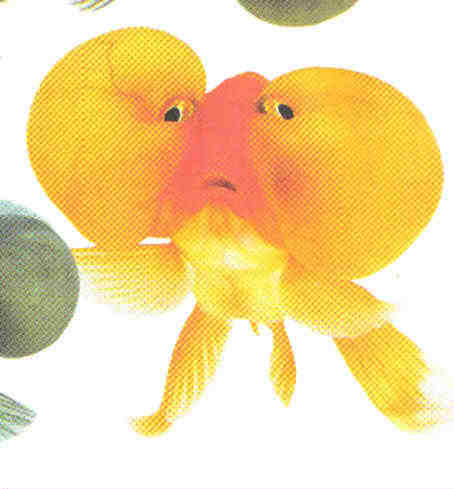|
|
Goldfish -- the Bubble Eye
wikipedia
The Bubble Eye is a variety of goldfish, characterized by the
fluid-filled sacs it has underneath either eye. It is a 'fancy'
variety, its unusual shape the result of many years of selective
breeding.
Like the ranchu, the bubble eye lacks a dorsal fin, and has a
double tail. It occurs in a number of colors, including gold,
red, black, white, red-and-white, and calico. Its eye sacs
typically start small, and then grow as the fish does, partially
occluding its vision. Bubble Eyes can reach to 6 to 8 inches (15
cm) in length.
Caring for Bubble Eye Goldfish
While Bubble Eyes are as inexpensive and easy to find as other
fancy varieties, they are not recommended for beginning
fish keepers because their delicate eyesacs can be easily damaged
by rough or sharp surfaces, or by filter intakes. A Bubble Eye
should never be kept in a tank with anything abrasive, such as
most rocks. Should the eyesac become punctured, it is important
keep the water especially clean, or use a topical product like
Melafix, to stop the puncture from becoming infected. A punctured
sac will eventually heal and grow back, although it is almost
always scarred or misshapen after healing.
Additionally, because their eye sacs can grow quite large and
hamper their swimming somewhat, it is important that Bubble Eyes
only be kept with other slow goldfish (other Bubble Eyes,
telescopes, and Celestial Eyes are optimal, but many of the fancy
varieties are fine as long as the individuals are not aggressive
and as long as the bubble eyes get enough food).
Bubble Eyes prefer tanks with little or no current. They should
be kept in a minimum of 10 gallons (38 litres) of water per
fish, although 20 to 50 gallons (75 to 200 litres) may be
optimal, depending on the size of the fish. Although goldfish are
cold water fish, fancy varieties prefer that water temperature be
kept between 76 and 78 °F. be careful as some times it can be
erratic. At these temperatures, however, it is crucial that the
surface of the water be agitated enough to provide adequate
oxygen (lethargy and gasping are common symptoms of oxygen
deprivation, which may occur in still water anywhere above 70
°F). Using sufficient air stones and bubble walls to achieve
reasonable oxygen exchange, Bubble Eyes and other fancy goldfish
varieties may remain healthy up to 90 °F.
Picture Bubble Eye Goldfish

As with most aquarium fish, water changes should be performed
every week in a sufficient amount to keep nitrate levels below 40
ppm. If large amounts of water need to be changed to achieve
this, it is likely that the tank is too small.
Being a large-bellied 'fancy' variety, Bubble Eyes can get
intestinal problems if they eat too much processed food (as it
tends to expand in the stomach), and should generally be fed
sinking pellets as well as a variety of fresh fruits and
vegetables to avoid excessive ingestion of air. Excessive feeding
of processed fish foods, especially floating-type foods, can
cause constipation and swim bladder disease. Symptoms are an
inability to remain upright, floating at the top of the tank, or
sinking to the bottom. (These symptoms can also be caused by poor
water quality or by bacterial infection.) Fish with swim bladder
problems should be fasted for 24 hours and then fed frozen green
peas. Additionally, if using floating-type packaged fish food, it
is advisable to soak it in water to allow it to expand before it
reaches the fish's stomach.
History of Bubble Eye Goldfish
The Bubble Eye goldfish variety was first developed in 1908,
although there is evidence to suggest they existed in the
eighteenth century
Types & Varieties of Goldfish
|